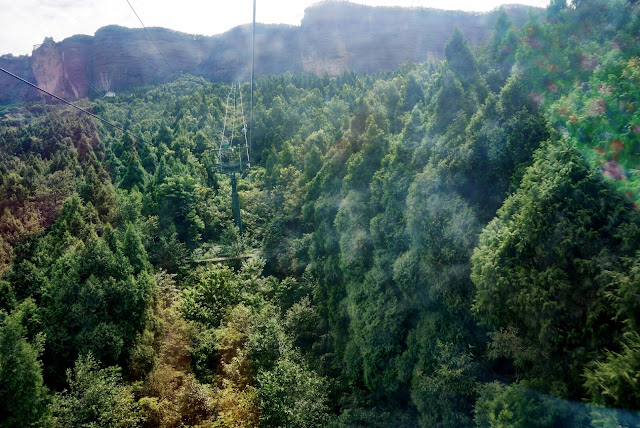To start our train ride to Lhasa we would embark at Xining 西寧 train station, which is about 1500 kilometers (930 miles) away from Chengdu. We would ride on a big bus for three days to go from Chengdu to Xining. The bus ride would follow the Ancient Shu Road 古蜀道, a part of the old Silk Road 絲路. Every day we would visit at least two sightseeing spots along this route to add varieties and excitements to an otherwise torturous journey. For this long-distance bus ride, the tour company assigned two drivers taking turns driving. Our ever helpful tour guide Titian had also diligently studied up on the Ancient Shu Road and was well prepared to share her knowledge.
The following map shows our bus ride for the next three days:
(Click on each picture to get the full-size view)
To zoom, click here: https://drive.google.com/open?id=1feIsRPQ6rdpQPLeyygpLCmsAVYA&usp=sharing
- The first day, we would start at point A (Chengdu), visit point B (Jianmen Pass 劍門關), point C (Zhaohua Old Town 昭化古城), and reach point D (Longnan 隴南).
- The second day, we would continue from point D, visit point E (Maiji Mountain Grottoes 麥積山石窟), point F (Tianshui 天水市), and reach point G (Linxia 臨夏).
- The third day, we would continue from point G, visit point H (Lanzhou 蘭州市), and reach point I (Xining), the final destination of our three days bus ride.
Our itinerary for today was a bus ride from Chengdu to Longnan, with two stops in between, for a road trip of about 505 kilometers (314 miles). We left the hotel at 7 o’clock in the morning, and before 10 o’clock we had arrived at our first stop, Jianmen Pass 劍門關, a mountain pass along the Ancient Shu Road. The mountain pass was flanked by steep cliffs on the sides of mountains and was a natural defensive location for the Ancient Shu Kingdom. The revered military strategist Zhuge Liang 諸葛亮 built a fort at this mountain pass. After constructions of several new roads bypassing the pass over the years, the fort has lost its military significance. It is now a popular tourist attraction.
Initial uphill incline toward the fort.

Taking a cable car made it easier.

View from the cable car. The steep cliffs flanking the mountain pass were at a distance.

After the cable car, hiking of a moderate distance was necessary to reach the fort. This location was the fork that separated the start of an ascending hiking trail and a paved passageway.

At this juncture, I couldn't help quoting Robert Frost:
"Two roads diverged in a yellow wood,
And sorry I could not travel both
And be one traveler, long I stood
And looked down one as far as I could
To where it bent in the undergrowth;"
and I decided to take the easy route.
For those not able or willing to climb uphill, there were shuttles-for-hire to take tourists to the end of this trail. This group of people took the easy way out and deprived themselves of the thrill and exhilaration of hiking on a magnificent trail.

Here were the lucky ones who challenged themselves and were richly rewarded with spectacular hiking scenes.


At the end of the trail, those who didn’t partake in the hiking challenge were able to pretend their participation.
On a short suspension bridge, the fort was visible at a distance.
The other side of the fort.

Statue of Zhuge Liang, the military strategist who built the fort.

An archway to the fort.

After Jianmen Pass, our next stop was the Zhaohua Old Town 昭化古城, a small town situated along the Ancient Shu Road.

The gate and an archway of the old town have weathered many dynasties, and they exhibited their ages impressively.
The main street and many side streets were quaint but very commercialized. They mainly were filled with countless stores selling food and tourist trinkets.

After nightfall, we reached Longnan, had dinner, and checked into our hotel. Tomorrow would be another long day on the road.
This map shows the first-day journey of our three days bus ride.
One of the greatest poets from Tang Dynastic, Li Bai 李白, once wrote a poem The Daunting Shu Road 蜀道難, in which both the Jianmen Pass and the Brocade City (Chengdu) were mentioned. From this poem, a phrase he used to describe the Ancient Shu Road, "Travelling on The Shu Road is harder than scaling the blue sky 蜀道之難難于上青天", has been quoted numerous times over many generations. Here is an excerpt from the poem with a rhyming English translation by anon.
劍閣崢嶸而崔嵬,
一夫當關,萬夫莫開;
所守或匪親,化為狼與豺。
朝避猛虎,夕避長蛇,
磨牙吮血,殺人如麻。
錦城雖雲樂,不如早還家。
蜀道之難難于上青天,
側身西望長咨嗟。
Jianmen Pass is steep and soaring,
One man could hold this pass, against ten thousands invading;
Its guardsmen are either bandit’s henchmen or wolf and jackal’s siblings.
By day we dread the savage tigers, by night the serpents rampant,
Sharp-fanged suckers of blood, slaughtering men down like stalks of hemp.
The City of Brocade may be pleasant, but best to return home urgent.
Traveling on The Shu Road is harder than scaling the blue sky,
I gaze into the west, and cannot help but heave sigh after sigh.













No comments:
Post a Comment